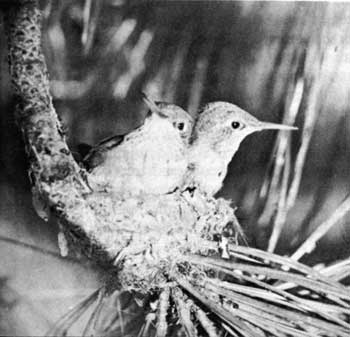|
BANDELIER National Monument |
 |

Two hummingbirds on a nest at the end of a pine
twig.
Several species of these birds are common at
Bandelier.
The Natural Scene
WILDLIFE. Of the larger animals, the mule deer are most commonly seen, becoming quite bold in Frijoles Canyon, where humans are familiar to them. Black bears are encountered occasionally on the trails in the back country, but are too wary to invade much-traveled areas. The shyest of them all, the mountain lion, leaves his footprints here and there, but is rarely seen. Smaller predators such as coyotes and foxes are numerous, as is the bobcat. These small hunters get most of their living from a large population of rabbits and small rodents such as ground squirrels and wood rats. For the visitor, one of the most popular wild residents is the tufted-eared Abert squirrel, which circulates decoratively through the pines and cottonwoods of the public campground during the summer.
The trees lining the Rito de los Frijoles through the Bandelier campground are a haven for birds as well as squirrels. In some spots, the shrubbery by the stream becomes jungle-thick, making a perfect small bird habitat. Probably the most common of the Frijoles Canyon songbirds, after the robin, is the black-headed grosbeak. Next in numbers comes the hermit thrush, followed by warblers, vireos, and western tanagers. But the bird most commonly heard in the canyon, and frequently seen around the ruins, is the canyon wren; the melody of his song brings life and brightness to the crumbled walls and the gloomy caves of the vanished people.
During the colder part of the year, the forests of Bandelier become the home of flocks of wild turkeys. These great birds stay high on the Jemez crest during the summer, but come down into the zone of oaks and pinyons to feed on nuts and acorns when the crops ripen in the fall. The turkeys are also very fond of the purple berries of the juniper, as are many other birds and virtually all of the small rodents of the locality.
Down along the Rio Grande, which makes the southeast boundary for the main part of the monument, there is a rewarding variety of plants and animals for those who wish to walk or ride horseback the 3 miles from headquarters. The river at this point is midway in its passage through White Rock Canyon, a roadless stretch of steep walls and boulder-strewn rapids. Here, the fringing willows and cottonwoods are festooned with wild grape vines; these green tangles provide food and shelter for a great community of birds, insects, and reptiles. Flycatchers are everywhere over the river in the summer, taking water-dwelling gnats and insects from the air. Swallows and swifts further the inroads on the insect population. On shore, water snakes and an occasional rattler take the sun and keep watch for the unwary lizard or rodent which will make a next meal.
The river is a major flyway for migrating water birds, and in the course of 12 months a large traffic of ducks, geese, and shore birds may be seen going north or south. There is other wild traffic along the Rio Grande, mostly evidenced by tracks left on the mudbanks and sand bars—mink, beaver, and rarely an otter follow the stream in their water-borne prowlings. The beavers seem to be resident on the monument in White Rock Canyon, although the Rio Grande is too large to allow them to build dams; the unmistakable beaver-tooth pattern on sapling stumps is frequently seen along the riverside. On the headwaters of the Rito de los Frijoles, about 9 miles above monument headquarters, a permanent colony of beavers is established, pioneered long ago by some migrant pair who left the big river to venture up the tiny tributary.

|

|
|
Last Modified: Sat, Jan 6 2001 10:00:00 am PDT |


